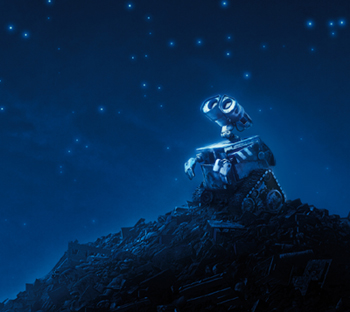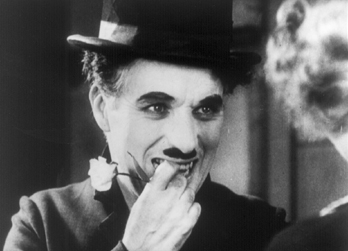As I watched it, I couldn't help thinking how much it reminded me of
a Charlie Chaplin film. First of all, take WALL·E, the lovable
tramp who's little, run-down and funny-looking but finds a whimsical
beauty in the world around him. He falls for a taller, more graceful
robot, the equivalent of, say, Edna Purviance in Chaplin's early films.
At first, she seems completely unachievable, but much like Edna in all
the Chaplin shorts, she appreciates beauty, as well, and soon is won
over by his gentle charm.
Typical of a Chaplin film, whether it's a short or The Gold Rush,
or the later classic, Modern Times, our little tramp must
face challenges, going up against the societal forces that try to tear
him apart from his newfound love. To achieve this goal, he must leave
his comfortable environment and take risks, finding within himself a
bravery that even larger robots might not possess. Think of Chaplin
standing up to burly toughs in The Gold Rush, or Chaplin confronting
injustice and taking a stand for the little man in Modern Times.
Counterpointing the romance and societal commentary, the movie makes
great use of slapstick, which is impressive given that WALL·E
is essentially a rolling trash compactor. WALL·E's face is remarkable
expressive, due to the independent function of his two eye pieces, which
can produce a variety of facial expressions. But his actions are both
in keeping with his physical limitations and hilariously human. This
shouldn't be a surprise: Pixar is a master of imbuing inanimate objects
with human characteristics. Think of the classic early Pixar shorts
featuring a desk lamp, which now serves as the company logo.
Just like Chaplin, at times WALL·E is fearful, and might hide
in plain sight by standing still and putting something on top of his
head (like Chaplin with a lampshade). At other times, he is mischievous,
acting up in the face of authority, literally booting people with his
tire treads in classic Chaplin form.
As any Chaplin fan knows, his comedy went beyond the artistry of his
slapstick or even the expressiveness of his acting. His films, whether
they were shorts or features, always focused on good storytelling. That's
what Pixar does especially well and why they continue to be a force
in the animated world. Even with characters whose vocabulary consists
of a handful of words, said with different intonations for different
meanings, we get a sense for the personalities of these characters.
Through action and minimal dialogue, they create a richly textured world
and tell a sweet, if cautionary, tale.
The best Chaplin films also contained a societal critique, whether
it was an examination of homelessness and disability, as in City
Lights, or international political commentary, as in The Great
Dictator. His films always contained observations about who we were
as a people, with the Little Tramp was an everyman, navigating those
issues from an outsider's position.
In much the same way, WALL·E is at home in his junk-strewn world,
but when he follows his beloved into space, he encounters a foreign
world which evokes aspects of our modern culture: rampant consumerism,
mindless conformity and a throwaway society. As he treads through this
world, leaving his distinctive mark as he goes ("foreign contaminant,"
one robot grouses as it follows him, cleaning up his oily tracks), he
shows us a path for finding the beauty around us and shaping a better
world through cooperation and optimism.
WALL·E is destined to become a classic. No matter what happens
in our society, this simple, well-told story, like the best works of
Charlie Chaplin, will continue to move us, inspire us and make us smile.



